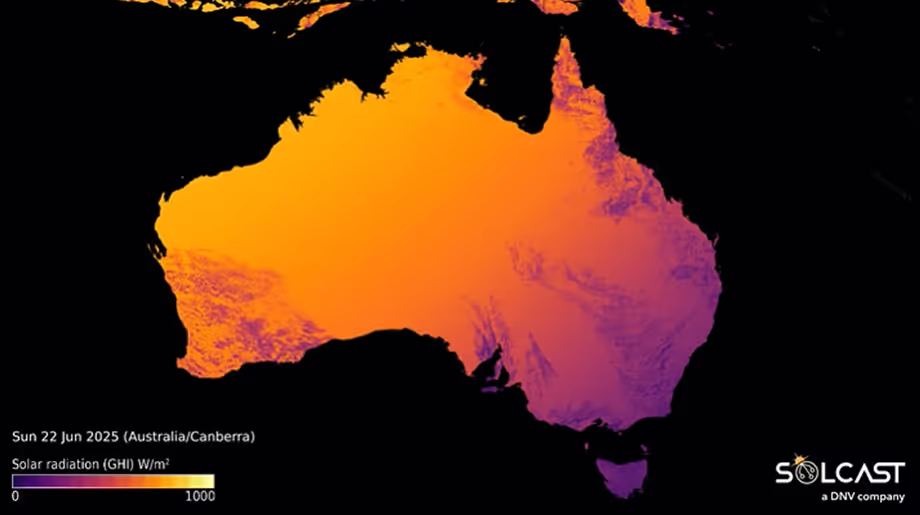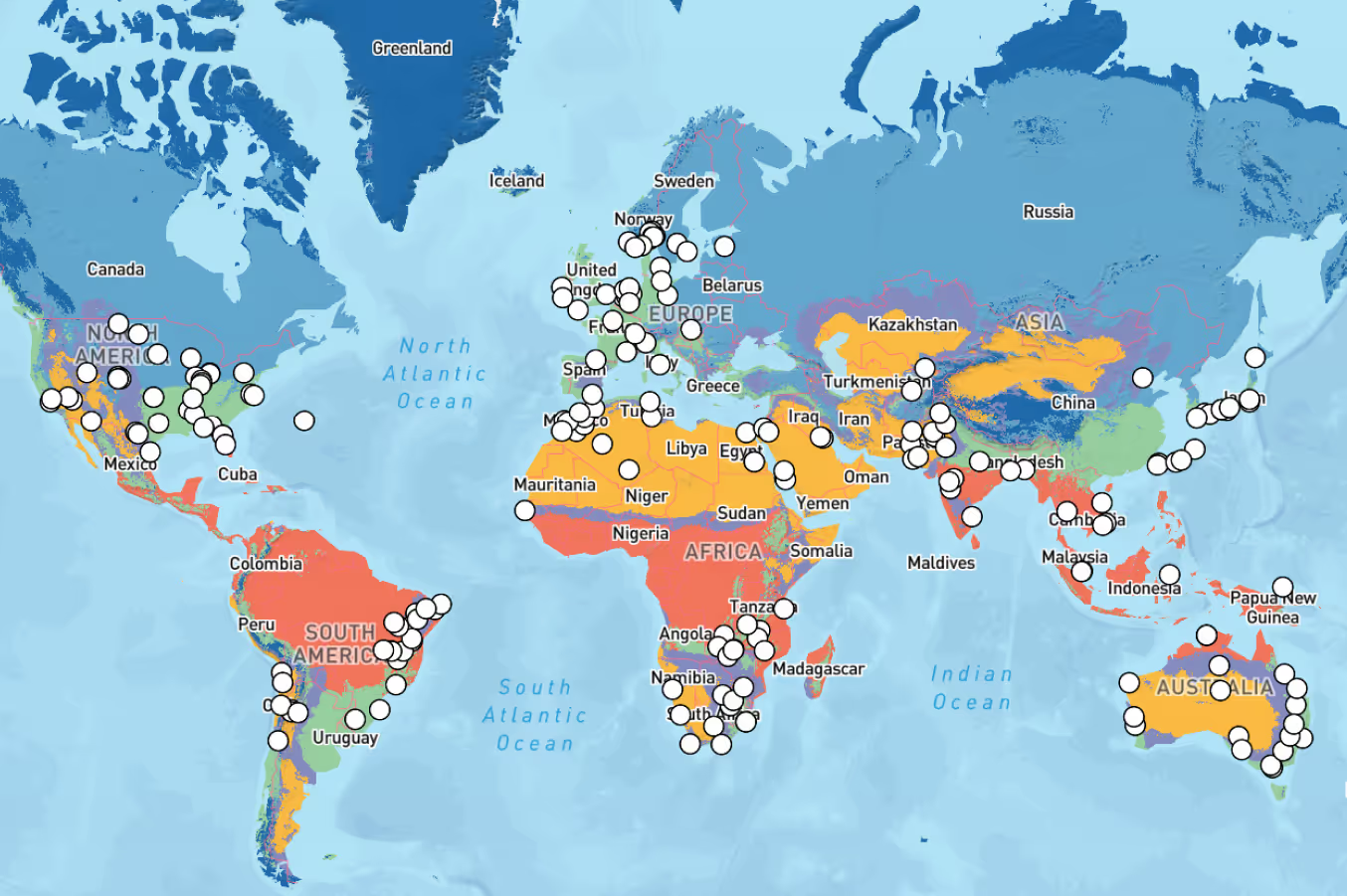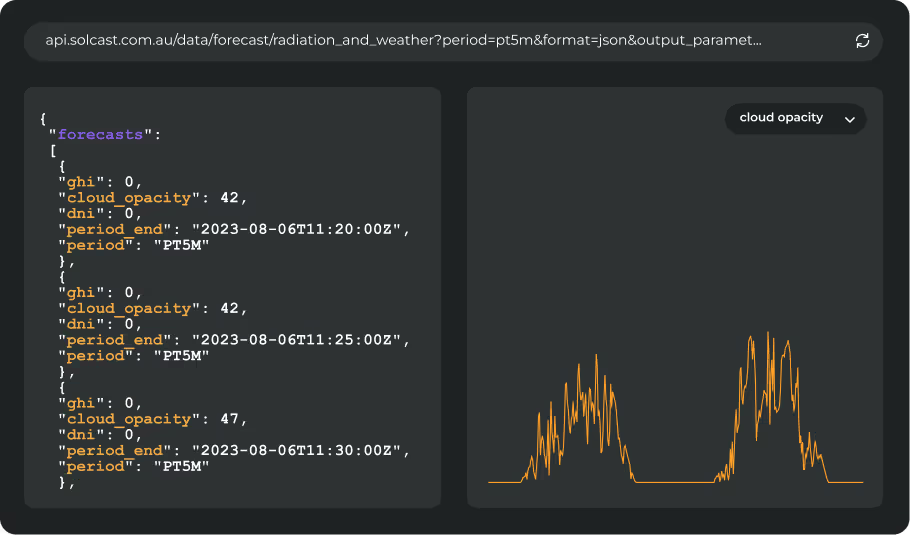Rooftop
PV Model
PV modelling methodology and specifications of Solcast's Rooftop PV Model

This page outlines the PV modelling methodology and specifications of Solcast's Rooftop PV Model, through which users can access forecasts and modelled actuals with global-coverage across Live (-7 days to present moment), and Forecast (present moment to +14 days) time periods.
Model overview
The Solcast Rooftop PV Model, which produces the data parameter Rooftop PV Power Output (kW) is an empirical PV model, designed for modelling the production from rooftop PV systems (particularly fleets) with limited system specifications available. This model is limited to four system specifications: system azimuth and tilt, AC capacity, and a bulk loss factor. Because of this limited specification, there is no need for the creation of sites as with the Advanced PV model. Users simply make their API requests by referencing the latitude and longitude and capacity at a minimum, and also the azimuth tilt and loss factor if known. Some users cluster nearby systems (<5km) together, using known or assumed average values of these specifications.
The Solcast Rooftop PV Model is used by Solcast in the production of its behind-the-meter Grid Aggregations data product, which provides production estimated actual and forecast data for network assets or grid regions of any size from neighbourhood to continental scale. For more information on this product, refer to the Grid Aggregations Product Guide and Specifications document.
Input data
The Rooftop PV model uses Solcast's irradiance and weather data as its time-dynamic input. The Solcast data parameters used by the model include irradiance parameters Direct Normal Irradiance (DNI) and Diffuse Horizontal Irradiance (DHI), ambient Air Temperature, and a dynamic site-specific Snow Soiling Loss – Rooftop based on irradiance, temperature and precipitation. For more information about this input data, please refer to Solcast Irradiance and Weather Data Inputs and Algorithms documentation.
Model development and applications
The Solcast Rooftop PV model is designed to estimate production from a fleet of PV systems where system specifications, shading and other losses are poorly known at individual system level, and where system output measurement data is incomplete and/or not available in real time. The model can also be used to estimate system geometry and losses from measurement data. The original version of the model is described in Killinger et al., 2016 ("Projection of power generation between differently-oriented PV systems." Solar Energy 136: 153-165). During 2016 to 2019 the model was refined at the Australian National University in a $2.6M ARENA industry research project, and thereafter was licenced to Solcast. The model is now in operational use globally by a range of TSOs, Utilities and load forecasters in Australia, Taiwan, Korea, US, UK and Germany. Each deployment of the model has included local calibration and validation in concert with users.
The model is empirical, consisting of a fitted quadratic function of the plane-of-array irradiance and air temperature (and their interactions), and the loss factor. The quadratic coefficients and the loss factor are fitted to measured inverter output (AC) data from a range of PV systems targeted at performance for specific countries.
The model output is in terms of inverter output (AC) power. In cases where installed capacity data is in terms of module (DC) capacity, the model loss factors can be calibrated using inverter output (AC) power measurements. This approach does not invalidate the shape of model's power curves so long as very high inverter loading ratios (ILRs) (e.g. >1.25) are not so dominant amongst the fleet so as to overwhelm shading, soiling and other loss factors that drive the shape of the power curve.
Improving forecast accuracy with site measurements
While the Solcast Rooftop PV Model delivers accurate power output forecasts with minimal data, incorporating site measurements can further enhance the forecast's accuracy. By using recent power production history, users can fine-tune their models to account for localized factors like shading and variations in array orientation, leading to more accurate rooftop PV forecasts. This is particularly useful for predicting solar production and optimizing battery control for residential customers.
Try the Solcast API
Solcast takes on the many challenges of producing live and forecast solar data, so that you don’t have to. That means making the data easy to access, validate and integrate. We provide instant access to live and forecast data products via this web interface, which is free to try. These include direct estimates of global, direct and diffuse solar radiation, as well as PV power output.
Commonly Asked Questions about Rooftop PV Model
What are the most important design parameters to consider when developing a Rooftop PV model?
The Solcast Rooftop PV model uses key parameters including system azimuth and tilt, module capacity and efficiency, snow soiling, and weather conditions (such as irradiance and temperature). These parameters significantly influence the accuracy of the power output estimation.
What is the ideal azimuth and title angle for rooftop PV panels?
The ideal tilt angle for rooftop PV panels depends on the geographic location and the latitude of the installation site which you can input when making Solcast API requests. The ideal azimuth angle for rooftop PV panels is typically true south in the Northern Hemisphere and true north in the Southern Hemisphere.
What is the difference between AC and DC in rooftop PV systems?
In Solcast rooftop PV systems, DC (Direct Current) refers to the electricity generated by the solar panels, while AC (Alternating Current) is the electricity output after it has been converted by the inverter for use in the grid or home. The Solcast model is calibrated to inverter output (AC) data from many systems.
What are the common challenges in rooftop PV modeling?
Common challenges include accurately capturing the variability in solar irradiance due to changing weather conditions and accounting for the specific characteristics of each PV system, such as tilt, azimuth, and shading.
How can site measurements improve the accuracy of rooftop PV power forecasts?
Site measurements, such as historical power production data, can be used to fine-tune a rooftop PV power model. This tuning process helps capture specific factors like shading from trees or buildings, which can vary throughout the year, leading to more accurate power output predictions.
Is it necessary to develop a custom PV model, or can existing models be adjusted for accuracy?
Rather than building a custom PV model from scratch, which can be time-consuming and prone to errors, using and tuning an existing rooftop PV power model can be more efficient. This approach ensures that important factors like shading and snow soiling are accurately accounted for, leading to better forecast performance.









.avif)


